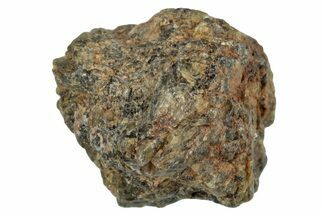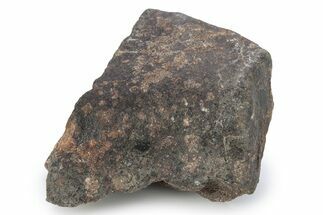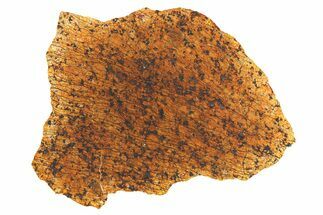This Specimen has been sold.
.56" Chondrite Meteorite Fragment (2.4 g) - NWA 7963
This is a .56" wide (2.4 gram) fragment of the chondrite meteorite NWA 7963.
NWA 7963 is the name given to an LL5 chondrite found in the western Sahara sometime in 2013. The find consists of a single stone weighing about 460 grams, and was purchased in Agadir, Morocco from a meteorite prospector.
Fusion crust covers about 65 percent of the total mass, and its exterior surfaces contain a few regmaglypts. The interior displays brecciated textures with indistinct chondrules, plagioclase, apatite, and grains of nickel-iron and iron sulfides.
Fusion crust covers about 65 percent of the total mass, and its exterior surfaces contain a few regmaglypts. The interior displays brecciated textures with indistinct chondrules, plagioclase, apatite, and grains of nickel-iron and iron sulfides.
About Chondrites
A chondrite is a stony (non-metallic) meteorite that has not been modified by either melting or differentiation of the parent body. Chondrites are formed when various types of dust and small grains in the early Solar System accreted to form primitive asteroids. Some such bodies are captured in the planet’s gravity well and pulled to the surface. They are by far the most common type of meteorite, representing about 86 percent of all meteorites that have fallen to Earth.
Prominent among the components present in chondrites are the enigmatic chondrules, millimeter-sized spherical objects that originated as freely floating, molten or partially molten droplets in space; most chondrules are rich in the silicate minerals olivine and pyroxene. Chondrites also contain particles of various metals such as nickel, iron, and aluminum. These formed at the very beginning of the solar system and aggregated over time: they are the oldest rocks known on Earth!
Chondrites are divided into about fifteen distinct groups on the basis of their mineralogy, bulk chemical composition, and oxygen isotope compositions. The various chondrite groups likely originated on separate asteroids or groups of related asteroids. Each chondrite group has a distinctive mixture of chondrules, refractory inclusions, matrix (dust), characteristic chondrule sizes, and other components. Other ways of classifying chondrites include weathering and shock. The L chondrite group is the most common of these.
A chondrite is a stony (non-metallic) meteorite that has not been modified by either melting or differentiation of the parent body. Chondrites are formed when various types of dust and small grains in the early Solar System accreted to form primitive asteroids. Some such bodies are captured in the planet’s gravity well and pulled to the surface. They are by far the most common type of meteorite, representing about 86 percent of all meteorites that have fallen to Earth.
Prominent among the components present in chondrites are the enigmatic chondrules, millimeter-sized spherical objects that originated as freely floating, molten or partially molten droplets in space; most chondrules are rich in the silicate minerals olivine and pyroxene. Chondrites also contain particles of various metals such as nickel, iron, and aluminum. These formed at the very beginning of the solar system and aggregated over time: they are the oldest rocks known on Earth!
Chondrites are divided into about fifteen distinct groups on the basis of their mineralogy, bulk chemical composition, and oxygen isotope compositions. The various chondrite groups likely originated on separate asteroids or groups of related asteroids. Each chondrite group has a distinctive mixture of chondrules, refractory inclusions, matrix (dust), characteristic chondrule sizes, and other components. Other ways of classifying chondrites include weathering and shock. The L chondrite group is the most common of these.
TYPE
Ordinary Chondrite (LL6)
LOCATION
Northwestern Africa
SIZE
.56 x .5 x .36", 2.4 grams
CATEGORY
ITEM
#281081
 Reviews
Reviews












